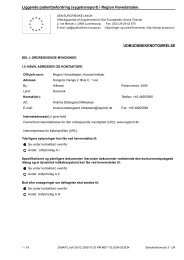Territorial Review Copenhagen - Region Hovedstaden
Territorial Review Copenhagen - Region Hovedstaden
Territorial Review Copenhagen - Region Hovedstaden
Create successful ePaper yourself
Turn your PDF publications into a flip-book with our unique Google optimized e-Paper software.
128<br />
exams. This system gives universities a stake in making sure that their<br />
students succeed in their studies. Universities with motivated and qualified<br />
students who complete their studies and pass their exams in the prescribed<br />
period of time obtain the highest grants.<br />
The key challenges facing <strong>Copenhagen</strong>‘s human capital formation can<br />
however only be addressed by addressing the question of the grants system<br />
for students. As mentioned earlier, higher education in Denmark is free and<br />
students are awarded grants to support their living costs for a maximum of<br />
six years. Students are not obliged to start their higher education studies<br />
immediately after secondary school. This leads to considerable delays before<br />
students start their education, and results in graduation at a relatively late<br />
age. The result is a shorter period of availability on the labour market in<br />
comparison with other OECD countries, and increased dropout rates. Since<br />
the grants offer students support for a longer period than is strictly necessary<br />
to finish a course of study, many are tempted to take additional courses,<br />
which can arguably be considered education consumption rather than an<br />
investment in skills that are in demand on the labour market. As education is<br />
free, students have fewer incentives to choose a study that correlates with<br />
labour market needs.<br />
Denmark‘s generous grant system and free education discourage<br />
international mobility. For a person who has studied in Denmark, it pays to<br />
move abroad and work in a country that has lower tax rates for high-income<br />
earners. For highly skilled foreigners, Denmark‘s high marginal taxes could<br />
be especially unattractive considering the large tuition debts they may have<br />
accumulated from studies at top US universities (OECD, 2006). This places<br />
<strong>Copenhagen</strong> at a disadvantage by comparison with other OECD<br />
metropolitan areas.<br />
Despite many laudable efforts, universities in <strong>Copenhagen</strong> could do<br />
more to stimulate the global outlook of their student population. Several<br />
universities have attempted to increase accessibility for foreign students.<br />
The University of <strong>Copenhagen</strong>, for example, offers more than 500<br />
individual courses in English at either bachelor (BA) or master (MA) level<br />
each semester. These courses are open to Danish and international students<br />
in all of their eight faculties. The IT University of <strong>Copenhagen</strong> offers<br />
interaction with Chinese students. In general, however, universities in<br />
<strong>Copenhagen</strong> have not engaged in strategic global interactions to attract new<br />
international students. There are few joint studies with renowned foreign<br />
universities or institutes in emerging markets.<br />
Further co-operation within the Øresund <strong>Region</strong>, via the Øresund<br />
University, could prove beneficial. The university is a voluntary<br />
organisation of 14 higher education institutions in the Øresund <strong>Region</strong>,

















